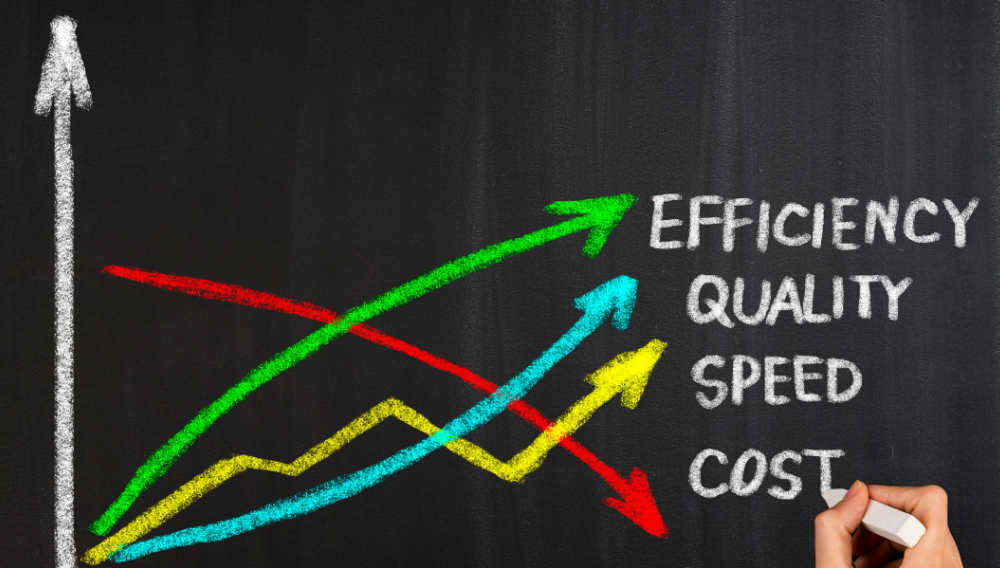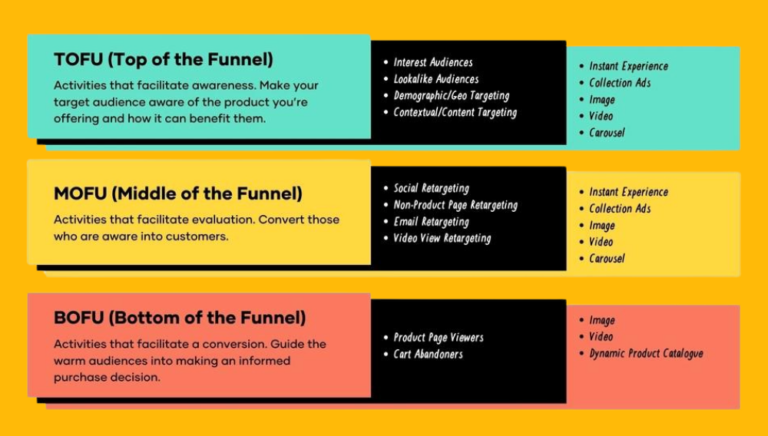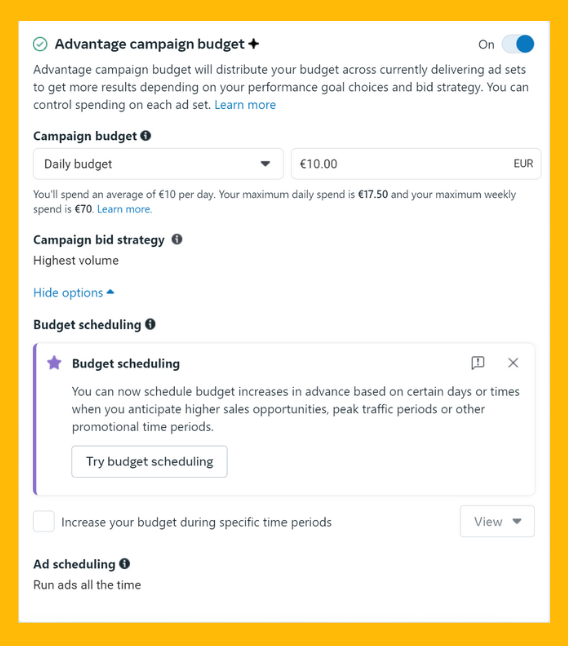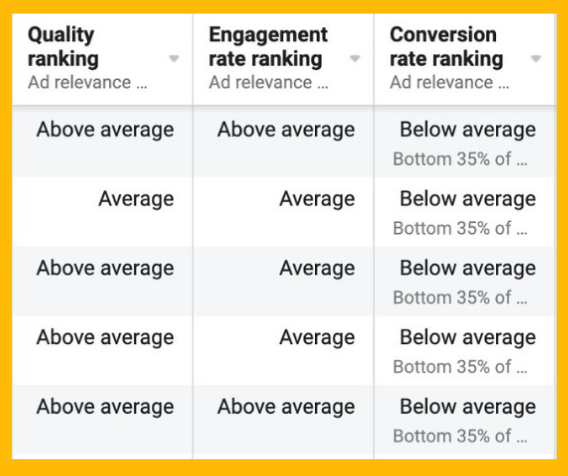
7 Unique Approaches to Scale Your Facebook Ads
Scaling Facebook ads is an exciting milestone.
It means you’ve nailed down a proven offer with the right target audiences, ready to scale up and elevate your business to the next level.
But it’s not as simple as just increasing your budget and expecting a proportional increase in revenue. There’s both an art and a science to scaling.
Curious about how to apply this to your advertising campaigns?
Below, we outline 7 unique tips and strategies to help you scale your Facebook ads.
Why You Need A Strategy To Scale Your Facebook Ads
Being active on social media is important for brand awareness. Having a content strategy can bring additional benefits.
It’ll save you time
It might seem like creating a strategy is time-consuming, but in reality, it saves you time in the long run. With a plan in place, you won’t waste time figuring out what to post at the last minute.
It supports your business goals
Your content should support your overall marketing strategy. By understanding your target audience, you can turn social media into a revenue-generating tool.
It’ll help you measure results
A content strategy helps you define and track the metrics that matter. You’ll know what works and what doesn’t, allowing you to adjust your approach for better results.
With a social media content strategy, you’ll define your most important metrics—those that indicate whether your strategy is paying off. It also gives eCommerce marketers a way to prove which formats and topics are most successful (so they can create more of it).
1. Split Campaigns into Funnel Stages
No matter what you’re promoting with your Facebook ads, most consumers go through similar buying experiences.
Our agency’s full-funnel Facebook Ads approach puts this into practice.
It enables you to deliver the right creative at the right time, based on the level of intent or awareness they have of your brand.
This approach creates a scalable campaign structure, ensuring you’re consistently bringing in new users without overlapping audiences.
Let’s dive into how we can scale Facebook ads using this funnel.

Top of the Funnel (TOFU)
TOFU (Top of Funnel) ads are crafted to introduce your product, brand, and the benefits you offer to your target audience.
Consider this the discovery phase, where you’re delivering creatives that resonate with people who have never heard of you before.
However, it’s crucial to stay focused on your objective. If you’re an eCommerce brand, for instance, your goal should be purchases—not just traffic or engagement.
As these campaigns run, you should continuously test new audiences, creatives, and ad copy to keep refining your approach.
Middle of the Funnel (MOFU)
The middle of the funnel is where you convert prospects into customers. These ads target people who are aware of your brand but haven’t yet visited your product pages. You should still be aiming for purchase conversions at this stage.
Key audiences include:
People who have engaged with your social channels in the past 180 days
People who have watched a video from your TOFU campaigns
Visited your home page, but haven't visited a product page.
But excluding audiences such as:
Visited a product page
Purchased
At this point, it’s important to be aware of ad fatigue. You don’t want to exhaust your audiences before hitting them with BOFU (Bottom of Funnel) ads.
Bottom of the Funnel (BOFU)
The BOFU (Bottom of Funnel) ad stage is where you can go for the hard sell, targeting warm audiences with direct calls to action, like directing them to product pages or offering discount codes to encourage a purchase.
When creating ad sets based on funnel stages, it’s vital to exclude people from all but the relevant ad set. For instance, your TOFU campaigns should exclude anyone already seeing MOFU or BOFU ads.
This ensures your TOFU campaigns continually feed your retargeting audiences. As people meet the targeting criteria, they automatically progress from one ad set to the next.
2. Continually Test Your Audiences
When scaling your Facebook ads strategy, we suggest grouping interest audiences by theme into a single ad set. This approach gives Facebook a pool of users with similar interests while keeping it broad enough to let Facebook find the right people. For example:
Ad Set 1 – Women’s Fashion, Sustainable Fashion, Dresses
Ad Set 2 – Competitor Brand 1, Competitor Brand 2, Competitor Brand 3
In addition to interest groups, it’s important to leverage pixel and CRM data to create lookalike audiences of high-value spenders and frequent purchasers.
For your prospecting (TOFU) campaigns, we recommend using at least five ad sets for effective audience targeting:
Three of them interest groups
Two of them lookalike audiences
After gathering enough data, take the time to analyze the performance of each ad set. You’ll likely find that certain audiences perform better than others. As you refine your targeting or test new audiences with different ads, you can start feeling more confident about scaling your ad spend.
3. Automate Budgets
As your ad results improve, make use of Facebook’s Campaign Budget Optimization feature. This is particularly effective for campaigns with two or more ad sets.
Budget optimization can help with:
Reducing the number of budgets you’re having to manually manage
Maximising your campaign results
Setting a flexible budget across your campaign
With Campaign Budget Optimization (CBO), the budget is allocated in real-time to the ads with the best performance potential throughout your campaign.
(Note: Campaign budgeting differs from ad set level budgeting, which allocates the budget at the ad set level.)
With campaign budgeting, you set the total budget for the entire campaign. You can choose between a daily budget or a lifetime budget while scheduling your ads. How you distribute your campaign budget should be based on campaign-level data analysis.
To effectively manage Facebook’s Campaign Budget Optimization feature:
- In your Ads Manager, navigate to your Campaigns tab
- Choose your existing campaign
- Scroll down to Budget & Scheduling to set your campaign budget
- Navigate to Ad Scheduling settings to determine when to run the ads in your campaign

4. Our Secret All of Funnel Strategy
AOFU, or ‘All of Funnel,’ steps outside the traditional campaign structure by aiming to reach the broadest audience possible, which helps with scaling.
To set up an AOFU campaign and connect with potential customers who might not fit your usual target audience, create a separate campaign with open targeting. Set the audience to include anyone aged 18 to 65, while maintaining typical exclusions.
Why does this approach work?
It leverages the platform’s machine learning and optimization to reach individuals who might not be captured in your standard prospecting campaigns (like interests and lookalikes). Often, these campaigns turn out to be our best performers!
5. Our Secret All of Funnel Strategy
People prefer to see ads that are relevant to them. Facebook’s auction system aims to provide high-quality experiences by showcasing relevant ads. Ads considered higher quality perform better in the auction, while less relevant ads cost more, see reduced distribution, and deliver fewer results.
Facebook’s quality ranking compares your ads to others competing for the same audience. The platform’s ad relevance diagnostics help you identify underperforming ads across three key elements:
Quality
Engagement
Conversion
Facebook assesses ad quality based on feedback from users who view or hide your ads, and by identifying low-quality elements like sensationalized language, engagement bait, or withheld information.
You can view your ad’s quality score in the Ads section of Facebook Ads Manager. This is one of three new metrics that have replaced the previous Relevance Score metric.

Three ways to improve your ads quality ranking are:
Certain social media tools—including Facebook Page Insights and Instagram Insights—also provide brands with a deep dive into their existing audience. You’re able to see information about your followers, such as:
Run more video ads.
People engage with video ads three times more than with static images. Video ads are effective at grabbing viewers' attention and encouraging action, which can lead to a higher quality ranking.
Don’t run the same ad too often
The more often a Facebook user sees the same ad, the more likely they are to hide or block it, which can negatively affect your quality ranking.
Test ads
Facebook’s auction is simple: The higher your click-through rate (CTR), the lower your cost per click (CPC). Experiment with different formats, colors, calls to action, images, and more to find what resonates best with your audience.
Facebook ad quality ranking can directly impact your cost per click. It also changes how frequently Facebook shows your ad to a specific audience. Take the time to continually test and optimize your Facebook ads to get better results from them.
6. Duplicate Successful Ads; Kill Underperforming Ones
A common and effective tactic for scaling ad spend is to duplicate successful ads while discontinuing underperforming ones. Ideally, every ad you create would perform well enough to keep running, but that’s rarely the case with Facebook.
You may find some ads performing decently, while your top ad is driving significant sales and conversions. Congratulations! This indicates that you’ve nailed both your targeting and ad creative strategy.
At this point, you’ll want to focus on that successful ad and duplicate it. How do you go about doing this?
- In your ad account’s Ads Manager, navigate to Campaign
- Find your ad and click on Duplicate
- Choose the number of copies you want to make across the appropriate campaigns and ad sets
- Make any additional changes and click on Publish

7. Take a Holistic Approach to Attribution & Adjusting Marketing Spend vs Revenue
With the recent iOS14 changes affecting Facebook ads, it’s crucial to take a broader view of your attribution and overall site performance.
Although these changes only impact iOS14 users, they influence how you optimise and target your Facebook ads. Advertisers now have a limited number of conversion events to optimise, which restricts your data points.
This poses a particular challenge for smaller businesses with smaller audiences. Additionally, as more people update to the latest iOS version, your retargeting audience may shrink.
Be aware of ad reporting data delays as well. Data from iOS 14.5 users will be delayed by three days due to Apple’s Private Click Measurement protocol.
In short, you should consider as many data points as possible beyond the Pixel or algorithm for a more comprehensive view.
One workaround is to use Google Analytics to track website visitors and conversions, and to monitor the performance of your landing pages.
While the iOS update limits the detailed marketing metrics Facebook can gather, it’s essential to factor this in when making scaling decisions. Use a mix of data sources to ensure your decisions are based on accurate information.
We also recommend looking at a blended ROAS, especially when using multiple paid media channels, as it’s crucial to understand the true performance of your efforts.
While we use in-platform ad account data to guide our optimisation decisions, we always consider overall site revenue and performance to gauge the broader success of campaigns.
Think of your paid media spend as a percentage of your total site revenue. For example, if your marketing spend is less than 20% of your total revenue, you might be ready to scale budgets in the next month.
It can be challenging to shift to this perspective, especially when we’re used to having full visibility on performance. But now, we need to adopt a more holistic approach.
The key point here is: Unless you’ve got a huge social media management and marketing team, you shouldn’t spread yourself too thin by being on all of them. Pick two or three at most, and nail the places your target customer is most active first.
Ready to Scale Your Facebook Ads?
Scaling Facebook ad campaigns requires skill, patience, and some trial and error. What works for one business might not work for another, even within the same niche.
However, that doesn’t mean you can’t achieve stellar results by refining and optimising your strategy.
In fact, 93% of our clients see an increase in their return on ad spend when partnering with us—this is no accident. As a leading Facebook advertising agency, our media buying expertise and focus on ROAS are key components of our comprehensive digital marketing strategy.
You can either spend time figuring out a Facebook advertising and scaling strategy on your own, or you can leave it to us at HOT IRON Digital. The choice is yours.
